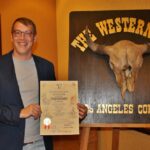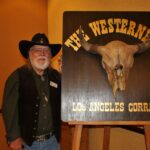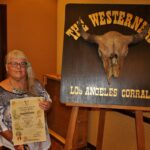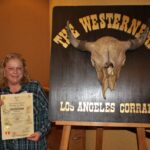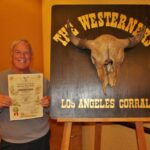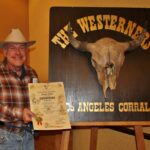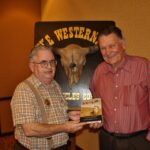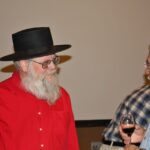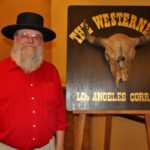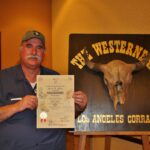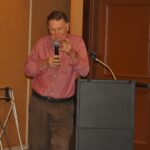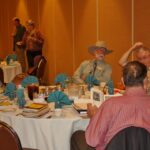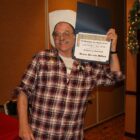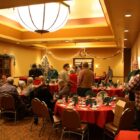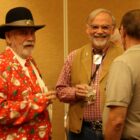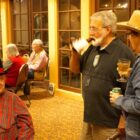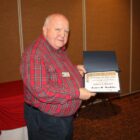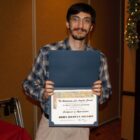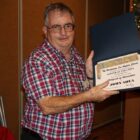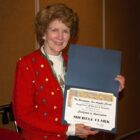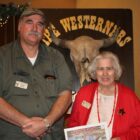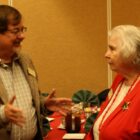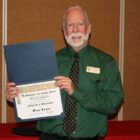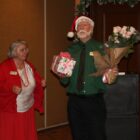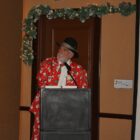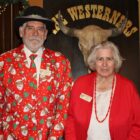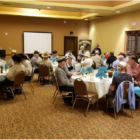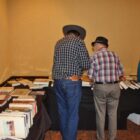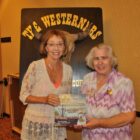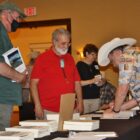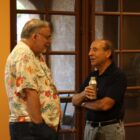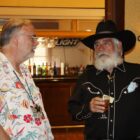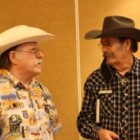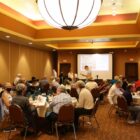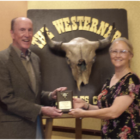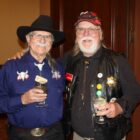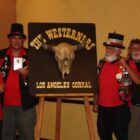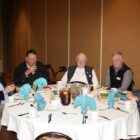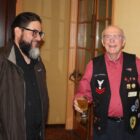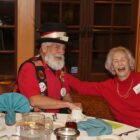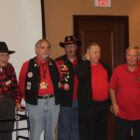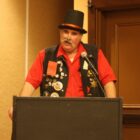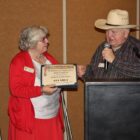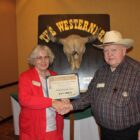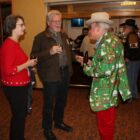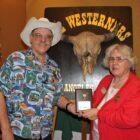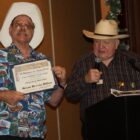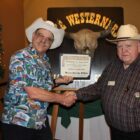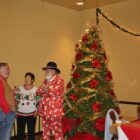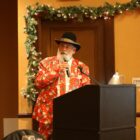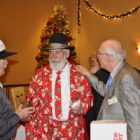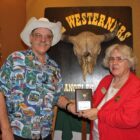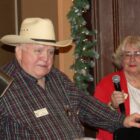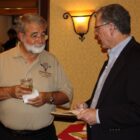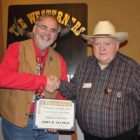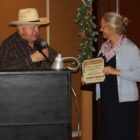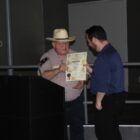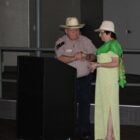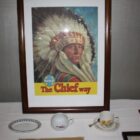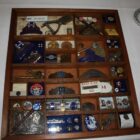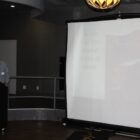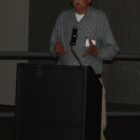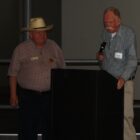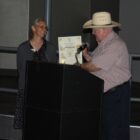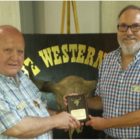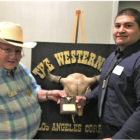Roundup: March 9, 2022
March 2022 Roundup Flyer
Roundup Synopsis
Taken From Branding Iron 306 Spring 2022.
In March, the Corral was treated to a talk by Nick Curry. Assuming the style of a fireside chat, Mr. Curry expounded on his research about a historic Angeleno of much importance, if little current recognition, Dan Murphy. Murphy was an early investor in the local economy and, along with men like Edward L. Doheny, helped shape the area into what it is today. In fact, Dan Murphy picked up with oil drilling in the area where Doheny left off, and became fabulously wealthy as a result. The foundation that resulted from the dissemination of his wealth has done much for education and the preservation of local history in Los Angeles.
Dan Murphy was born in 1858 in Pennsylvania, and came to Los Angeles by way of a family homestead in Kansas, which he shared with his parents and seven siblings. Murphy eventually moved out West and immediately formed an affinity for the railroad, working on a spur line that ran down to San Diego. Before long, he met Frank Monaghan, and the two had plans to bridge the Colorado River. Doing just that, they drew the attention of Charlie Crawford who tasked them with building a general store near the new bridge. In so doing, they founded the town of Needles in 1883.
The two men were known for their honesty, a rare commodity in the railroad business, and successfully ran the store until 1911. During their time in Needles, they founded a bank. This led them to invest in a number of mining and oil drilling operations throughout the region. Key to Dan Murphy’s future success was his purchase, sight-unseen, of land which would become the Brea Canyon Oil Company. The well, which continues to produce today, eventually left Murphy in possession of a fantastic mansion and a fortune of $200 million by the time of his death in 1939.
Having no children, Murphy entrusted his fortune to his niece Bernardine. Enter the Catholic church and the Los Angeles diocese. The Murphy family had been closely connected to the church for decades, so much so that Dan had once donated $1 million to the Pope in one lump sum. During her time in Rome, Bernardine, now the executor of the Murphy fortune, was wooed by an Italian prince. Los Angeles churchmen grew concerned that if Bernardine were to marry this man, then she, along with her fortune, would move to Rome and leave the Los Angeles diocese in the lurch. So, the church hatched a plan. A dissatisfied priest was found, released from his vows, and wed to Bernardine. Thus the Murphy fortune remained in Los Angeles. Now known as the Dan Murphy Foundation, it provides more money to Catholic causes today than even the Doheny Foundation.
The Dan Murphy Foundation was crucial to the formation of the archives put together by Westerners Living Legend Msgr. Francis Weber. That archive was, in turn, essential in gathering the information used for the most recent book about Dan Murphy entitled Ice and Oil, by Joseph Francis Ryan, reviewed in Branding Iron 303.
— Alan Griffin
Photos from the Roundup
Roundup: December 2021
Roundup Synopsis
Taken from the Winter 2021 Branding Iron.
The December Roundup was the last meeting of 2021, and of the Westerners’ brief return to in-person gatherings before Omicron forced a new wave of pandemic restrictions. Blissfully ignorant of this future, our meeting was animated with festive cheer, cherries jubilee, and philosophical questions like, “Are we alone in the universe?” The night’s speaker, Gary Turner, offered his answer by sharing his personal journey down the rabbit hole—or rather, up the tractor beam—of UFOlogy. Since the dawn of prehistory, humanity has looked to the heavens as the realm of gods and fate, and devoted lifetimes to divining the wisdom in the stars. Pilgrims to Roswell, New Mexico, have retraced this ancient process of mythmaking, with extraterrestrials becoming today’s celestial beings. Scientific certainty has made the night sky cold and lonely by removing its sense of mystery, but with a little imagination, it can still, indeed, be out of this world.
— John Dillon
Photos from the Roundup
Roundup: November 2021
Roundup Synopsis
Taken from the Fall 2021 Branding Iron.
In November, we all traded our Stetsons for silly hats, as Crazy Hat Night descended upon Almansor Court. As usual, three standouts were chosen to take home prizes in honor of their daring fashion sensibilities. Mike Johnson had family to thank for his absurdly tall rainbow squid hat. Hal Eaton donned a bovine beauty, complete with twitching ears, and Dorothy Mutz looked lovely and over the top in her rose-covered cartwheel. Thanks to everyone who threw caution to the wind and sailed the silly seas. I would like to take this opportunity to buck for the next Crazy Shirt Night to come soon!
The evening’s presentation was given by a trilby-clad Mark Mutz (clearly, his better half had more hat mojo working that evening). Mr. Mutz took us on a journey through some of the area’s communities, exploring their beginnings as “irrigation colonies” created by Canadian-born developer George Chaffey.
George Chaffey was a man who understood that land without water wasn’t worth much. As such, when he sought to sell parcels of land in his first development, Etiwanda, the water rights were inexorably tied to the land. Each parcel could be sold and transferred as any other, but its right to water always went with it. This practice led to a far less murky and litigious environment than the one it succeeded. Its “water corporation” concept quickly became the standard system of distribution for water rights in California.
The success of the Etiwanda colony led Chaffey and Holt to purchase 6,216 more acres nearby, for what would become Ontario. This colony was founded with four guarantees: water rights for every land owner, a construction plan for beautiful Euclid avenue, a planned college of agriculture— which later became Chaffey High School, and a prohibition against alcohol. These tenets struck a resounding chord in line with the mores of the burgeoning progressive movement, and Ontario’s parcels sold well, marking another successful venture for Chaffey hot on the heels of his first.
Not all of Chaffey’s endeavours would meet with the same success as Etiwanda and Ontario, however. There was his failed bid to plot the Werribee River valley in Australia, scuttled by drought, a banking crisis, and Chaffey’s construction of a fancy home for himself while most investors were struggling to make use of their land. Manzanar, though not a fiscal failure, never thrived as a colony because it was purchased entirely by Los Angeles, and is now best known as the site of the infamous WWII Japanese internment camp. Another project truly did end in disaster, though not entirely due to Chaffey’s actions. That was his diversion of part of the Colorado River to irrigate the Imperial and Coachella Valleys and the Salton Sink. Heavy rain and runoff destroyed a relief canal, causing a flood that damaged large amounts of property, and led to not only a lawsuit by Southern Pacific, but to formation of the Salton Sea as we see it now.
In all, an entertaining evening that was kicked off by some hilarious headwear was capped by Mark’s fascinating portrait of one of our region’s less-well-known early developers. We were all reminded that one’s name needn’t have been Griffith, Doheny, or Huntington to have mattered to the creation of our humble little corner of the state. See you all on Crazy Shirt Night, whenever that may be.
— Alan Griffin
Photos from the Roundup
Roundup: September 2021
WHOOPI-TY-AYE-OH No. 2
BACK IN THE SADDLE AGAIN
September Roundup
Wednesday, September 8, 2021
Almansor Court – 700 S. Almansor, Alhambra, CA.
Social Hour: 5:00 PM
Dinner: 6:00 PM
Our Speaker: Dr. Geraldine Knatz
Her Subject: The Port of Los Angeles
In one of dozens of classic lines from Chinatown, John Huston’s Noah Cross says to Jack Nicholson’s Jake Gittes that Hollis Mulwray made this city, adding that he also made Cross rich in the process. Theirs was a freshwater empire, made of a complex recipe: greed mixed with altruism, adding hydrology, intrigue, and murder.
Geraldine Knatz insists that what we might call the Los Angeles saltwater story, the Los Angeles Harbor story, is every bit as compelling, mysterious, dramatic, important. She insists that the Port of Los Angeles deserves to have its own tales narrated. And she is right.
The Port of Los Angeles made this city. Its history explodes the intimacy of a case study. It is far more important than that. It very well might be the study of what made modern Los Angeles.
Personalities, crimes, power moves disguised as bureaucratic banalities, jurisdictional feuds, and outright warfare—it is all here. So, too, is the way that the port has remained umbilical to Los Angeles: feeding it, for sure, but also tethering it to worlds an ocean away.”
Roundup Synopsis
Taken From Branding Iron 304 Fall 2021.
The guest speaker for the September Roundup was Geraldine Knatz, speaking about the early 20th-century history of the Port of Los Angeles, centered around her recent 2019 book, Port of Los Angeles: Conflict, Commerce, and the Fight for Control.
Thomas Gibbon in 1891 attempted to build a wharf on Rattlesnake Island (now Terminal island), on tidelands held by individuals erroneously sold by the state. His case was successful, but no action occurred until he was appointed to the Board of Harbor Commissioners in 1907, when he then pushed for the state to recover the property. An agreement was reached in 1917 for the property owners to turn the land over to the city in 30 years. This land would eventually become the Port of Los Angeles. Wilmington and San Pedro would eventually be consolidated with Los Angeles, with the tidelands being transferred to the city. Mormon Island, belonging to the Banning family, was also absorbed by the city in the 1930s after a long legal battle. Thomas Gibbon also attempted to have a railroad built, but this never saw the light of day.
In the 1920s Walter B. Allen was appointed to the Board of Harbor Commissioners, and was seen as someone who could clean up the corruption, though he had his own conflicts of interest in trucking port cargo with his own delivery company. Allen was tasked by the city mayor to merge the ports of Los Angeles and Long Beach. Politics, rate wars, duplicate facilities, and Los Angeles’ desire to control Long Beach’s oil money triggered many attempts to merge the two ports, but they remained separate. Allen was eventually removed due to bad publicity for his involvement with the Julian Petroleum scandal. Many years later Assemblyman Vincent Thomas would also attempt to merge the two ports and was similarly unsuccessful.
WWII forever changed the world’s appreciation of the port. Los Angeles proved that it could move more than just oil, and could be a general cargo port as well. Meanwhile the port customer base was shifting from locally based oil companies to international shipping companies. By the 1960s, trade through Los Angeles Harbor had grown faster than its terminal facilities, longshore workforce, and its own office space could handle. The 1960s for the harbor also saw exciting developments, as if ripped straight from the latest film noir: corruption, graft, secretly taped meetings, indictments, a suspicious death, and a Pulitzer Prize-winning exposé by the Los Angeles Times.
The Port of Long Beach would grow so rapidly that the Los Angeles Board of Harbor Commissioners voted to support merging of the two ports. We continue to hear past and present arguments supporting this initiative, but the ports of Los Angeles and Long Beach remain separate to this day
— Patrick Mulvey
Photos from the Roundup
Roundup: August 2021
Roundup Synopsis
In August, the Westerners held, possibly, the last of our web-based roundups. Serendipitously, our need to gather at a distance led us to join with the Hawaii chapter of the Tsung Tsin Association and Chinese genealogical organizations in San Francisco and Los Angeles. Together, we explored an area in which our respective spheres of interest overlapped. As such, we dipped our collective toes into the rich waters made up by the stories of Chinese immigrants to Hawaii and California. The gathering on August 23rd was the culmination of a special two-part series hosted by our newfound collaborators. It featured a lecture by Dr. Brian Dillon which focused on the experiences of Chinese immigrants in our part of the country and their influence in helping to shape the California that we see today. The introductory portion of Dillon’s talk reminded us that, until the latter half of the 20th century, the Chinese were all but omitted from the history of this country. When an author deigned to mention them at all, it often served only to perpetuate general misconceptions with something trite, along the lines of, “They built the railroads, then moved to San Francisco.” As we learned throughout Dillon’s presentation, the Chinese story in California is much more complicated. The construction of railroads was not the only undertaking of large numbers of Chinese workers, as they also left a significant stamp on the mining industry. Indeed, by 1854, as many as one-in-five California miners were Chinese, often working abandoned claims and making them profitable. Remnants of mining ditches, wagon trails, and irrigation canals hand-dug by Chinese, today serve as testament to their creators’ contributions to the progress of the West, apart from the railroads which made their fellows famous. Unfortunately, these Chinese immigrants were subject to terrible mistreatment in their new homeland. Racially motivated mass murders, including the largest lynching in California’s history in Los Angeles in 1871, were far from the only crimes to which these people were subjected by their white neighbors. Both rural and urban Chinese communities endured unfair hardships perpetrated by their neighbors. Making things worse, all levels of government, from local to federal, stripped the Chinese of their civil rights, making it impossible for injured parties among them to seek justice. The Chinese who stayed in California after the Gold Rush, being mostly single men, eventually died of old age. Their slow decline led to many “One-Man Chinatowns” dispersed throughout California’s small rural communities. Afterwards, urban Chinatowns became the last significant haven for California’s Chinese population. Some of these urban Chinatowns still thrive today. This cooperative presentation enabled us to learn more about the efforts of Chinese immigrants in the 19th-century development of our home state. Especially in this present, COVID-induced era of rising anti-Asian racism, it is essential that we celebrate such contributions and lament the mistreatment which is too often the only reward of such immigrants. Here’s to future communions with groups like the Tsung Tsin Association, which provide a great opportunity, for all involved, to incorporate new perspectives into our respective worldviews. — Alan Griffin
Roundup: March 11 2020
Roundup-Draft-2-March-2020-Bruce-Merritt
Roundup Synopsis
Given that we are all members (or fellows) of a historical society, interest was high in March when Bruce Merritt came to the Corral to explain the founding of another society, albeit one with a bit of a different bent than our own. The Society of Colonial Wars in the State of California was founded in Los Angeles in November of 1895 by Col. Holdridge Ozro Collins and U.S. Attorney George Jules Denis. The Society of Colonial Wars already existed in New York at the time of the founding of the California chapter, when a few enthusiastic newcomers sought to bring what was quickly becoming a national tradition out West to legitimize themselves and their city as truly American. Though the current state of the Society of Colonial Wars bears little resemblance to its configuration at founding, we Westerners were treated to a bit of the colorful history of its early members, and a glimpse into the motivations behind its origins. The Society of Colonial Wars in California sprang up in Los Angeles during what Mr. Merritt termed “the Golden Age of lineage societies.” This “Golden Age” came about in the latter half of the nineteenth century as three forces that had been growing within America converged to spur a flurry of society foundings. Patriotism was growing as Civil War wounds healed, anti-immigration sentiments prevailed as more now came from China and Eastern Europe, and Anglophilia was in vogue amongst the upper crust due to the glamour of some very high-profile marriages between American elites and British nobles. Societies spread like wildfire as people sought to not only rub elbows with the elites, but to preserve an American culture which they felt was being threatened. The group which responded to these forces in Los Angeles—Colonel Collins and associates—were about as diverse in background as a bunch of wealthy, middle-aged white men could be in 1895. There were former Confederates alongside Unionists, a Republican U.S. Attorney and one from the Democrats, as well as judges, politicians, speculators, and even a reverend for good measure. Among the men who came together to found the Society of Colonial Wars in the State of California, you’ll find names like Otis, Huntington, and Rindge. Less remembered are the likes of Motley Flint, who was shot dead in court for his involvement in a ponzi scheme, or Reverend Alexander Merwin, who built schools and churches for the Latino communities of Southern California. This early society was chock-full of characters. Today, the society bears little resemblance to its early form. It has become more focused on historical preservation, while dropping the anti-immigration and elitist attitudes which colored its early days. Though still male-only, the society now has several, lecture-focused, co-ed, public events each year. Mr. Merritt indicated that there is talk amongst the Society of Colonial Wars about incorporating more Spanish colonial history into their future efforts. If not, we Westerners will be there to pick up the slack! — Alan Griffin
Photos from the Roundup
Roundup: February 12 2020
Roundup-Announcement-February-2020-Randy-King
Roundup Synopsis
The American frontier crawled with gunslingers. Each one picked up the firearm for a different reason, and each one aimed for the same result; gun violence and death was a constant threat in the Wild West, whether the victims were implicated in crime and scandal, or if they were just in the wrong place at the wrong time. These circumstances made the firearm the be all and end all to both keeping the peace and disrupting order. The moral code of the time seems blurred to us, making judgment calls on four gunmen difficult—Pink Higgins, Luke Short, Jim Miller, and Bill Fossett. Charles King invited us to set aside our values to marvel at the spectacle that was the ruthlessness, the cunning, and the extraordinary careers of these four men.
Not every gunslinger can be called a ruthless killer, but they were killers nonetheless. Luke Short, a shrewd businessman and gambler, and Bill Fossett, a fearless lawman who climbed the ranks in a long career, both used force to overcome challenges. The American frontier pushed people to vice and violence in a way that left no room for polite diplomacy. Short escaped arrest after selling bootleg whiskey to Native Americans, and his business dealings landed him in one tricky situation after another. He made it big scoring ranch land, owning whiskey stocks, and running saloons, and with the help of his six shooter, he never let racketeers or corrupt capitalists get one over on him in his career.
Fossett’s career involved a more traditionally noble path, killing or capturing outlaws and running with peacekeeping posses. Even his daughter took after him in shooting and maintaining order on the frontier. For every morally dubious or righteous gunman, however, there was also a morally corrupt one— or, at least, one whose career of gunslinging can be harder to swallow.
Some men killed ruthlessly, amassing astounding body counts and defying the law at every turn. Whether their intentions were noble or not, the end results reveal the capacity for death and violence in the Old West. Pink Higgins and Jim Miller had drastically different lives as gunmen, with Higgins leaning toward the far more “righteous” of the two. He took the cowboy profession seriously, and as a range detective for the Spur Ranch in Texas, Higgins lynched many cattle rustlers. Higgins also feuded with the Horrell Brother outlaws, kickstarting his reputation as a gunslinger. While he was ruthless, Higgins directed his brutality toward criminals; Miller’s violence, on the other hand, is harder to reconcile by today’s standards of morality. Miller advertised himself as an assassin, accruing great wealth taking assignments, even during his work with the Texas Rangers. Not only did the Texas Rangers apparently tolerate his lucrative side job, but he had already managed to serve as a lawman in Pecos. A man of no vices save for profitable murder, Miller set a comically conflicting example for men in the Wild West.
Morality changes over the ages, and America being so young makes the jump in standards between eras look steep. King proposed that the concoction of booze, guns, and unsavory personalities lended to the “wildness” of the west, leaving behind a memory of lawlessness in our minds. He saw both marvel and horror in the histories of America’s famed killers. While he entertained the crowd with these stories, King also emphasized the importance in paying mind to the moral gap between the American frontier past and our present—not so far removed from our contemporary lives, and not a history we should honor without judgment. — Arkaz Vardanyan
Photos from the Roundup
Roundup: January 8 2020, ECV Night
January-2020-Roundup-ECV-Night-Final-Version
Roundup Synopsis
On E Clampus Vitus Night, fraternity members dressed in red to usher in the New Year at the first roundup of 2020. Clamper Mark Mutz took the floor to discuss the ins and outs of storytelling. Mutz uncovered the truth behind various legends about American history. He connected historical monuments of death and destruction with his experience as a curious young man in New England, an infantry sergeant from the Pacific Northwest to Kentucky, and as a resident in his current home in California. The tombstones he found throughout his life served as reminders of grim moments in the past often forgotten by the average American today—“A Soldier of the Revolution,” the Russian orthodox cemetery near Fort Richardson, Alaska, and the Civil War graveyards near Fort Campbell, Kentucky. Each marker told a story, and those stories contributed to Mutz’s endeavor to report on those stories in his newspaper, The Fence Post.
America was built on legends and continues to be spoken of in the language of these legends. The mythos surrounding the origin of Thanksgiving cracked under the pressure of Mutz’s corrections, and that same pressure challenged other popular misconceptions; the conquered Californios who fought back against American conquest with skill and bravery, as opposed to letting our country have an easy victory. Most fallacious of all, in Mutz’s eyes, would be the various paradoxes that make up America’s historic foundation. The fight for U.S. independence missed a true sense of universal patriotism as a mess of loyalism, fence-sitting, and opportunism stood in the way of unified dissent against the British. “Liberty and justice for all” applied only to a select portion of the American population for many generations. The existence of slavery and the disenfranchisement of women are two of the clearest examples of how America’s promise did not match up to reality.
How can a nation stand on so many contradictions? Mutz strives to take such contradictions apart. Their existence begs asking— does America stand because of a collective willingness to overlook errors in nationalist nostalgia? Many more factors put America in a good position to avoid discussing its checkered past, but a critical look at the historical record is necessary to stop the cycle of perpetuating a lack of awareness of our country.
— Arkaz Vardanyan
Photos from the Roundup
Roundup: December 11, 2019
Our Speaker: Brian Dervin Dillon, Ph.D.
His Subject: Wyatt and Josie Earp: Fact, Fiction, and Myth
Brian Dervin Dillon, Ph.D., Past Sheriff of our Los Angeles Corral, just received his 8th consecutive Coke Wood Award from Westerners International for his historical publications, one of which (2015) was on Wyatt and his wife Josie Earp. Brian’s family has a distant connection with that of the famous lawman, and Brian’s younger brother and co-author has worked for 30 years in the cemetery in Colma, California, where Wyatt and Josie are buried.
Dozens of Hollywood movies and hundreds of hours of T.V. programs have been devoted to Wyatt Earp. Almost every Tinseltown leading man, over the past 70+ years, has portrayed the hero of the O.K. Corral shootout. Earp himself was an advisor to early Hollywood “horse operas,” and both William S. Hart and Tom Mix were pallbearers at his 1929 funeral. But what just about every last big or small screen portrayal of Wyatt Earp has in common is an almost complete absence of facts. With the recent revelation that the supposedly definitive biography of Josie is fraudulent, it seems that no aspect of the lawman’s life was left untouched by fictionalizers and mythologizers. This promises to be a fascinating program to end our year.
Roundup Synopsis
Taken From Branding Iron 297 Winter 2020.
The Los Angeles Corral’s very own Brian Dillon was the speaker for the December roundup. Brian regaled us with the truth, lies, and legends about Wyatt and Josie Earp. Wyatt Earp has been portrayed as a hero in various forms of media for many years. He is represented as a lawman who seeks justice first and foremost. This is mostly fiction though. Earp was a deputy sheriff and deputy marshal, but he was also a pimp, a gambler, and, when he was young, a horse thief. So how did Earp get his good reputation while hiding his negative side? Enter Ned Buntline, the pseudonym for a hack fiction writer named Edward Zane Carroll Judson.
Buntline never wrote about Wyatt Earp, but he did start the American obsession with the Wild West that inexorably led to Earp’s stardom. His first creation was Buffalo Bill. The famous Wild West Show started on a stage in New York and expanded to the giant spectacle with which we are all familiar. From there the mythologizing moved onto the big and small screens. Earp worked as a consultant on some of these movies adding an air of legitimacy to the lies being fed to the public.
With all of the twin six shooter twirling cowboys running around on screen and in books, people started to actually believe what was being sold to them—even those feats that violated common sense or the laws of physics. Reenactments and theme parks perpetuate the fictitious version of the Old West. Ever present among the movies, books, and especially TV shows was Wyatt Earp, the steadfast lawman, keeping the west safe for women and children everywhere in nightly reruns of his shootout at the O.K. Corral.
Josie Earp was not immune to telling lies about her husband and his exploits. After Wyatt’s death in 1929, she sold off various guns that she claimed belonged to him. She was also not safe from lies being spread about her. A photograph of a woman in a very sheer dress was said to be a photo of Josie taken in the 1880s. But the photo was originally taken in 1914 in New York when she was 53 years old and 2000 miles away. That didn’t stop it from being used on the cover of an entirely fake biography of Josie.
Legends can be good as entertainment but that good goes away when they are presented as fact. A man who did a lot of bad things in his life portraying himself as an upstanding lawman isn’t good. When it leads to various authors and filmmakers embellishing, not just that man’s life, but also the world he lived in, that can be dangerous. A case in point being the downright stupid way most movie and television cowboys handle their guns, which they treat like stage props rather than deadly weapons. It can lead to unsafe behavior at the best and death at the worst. Pistol twirling cowboys are fun to watch but they aren’t real. They should remain in the land of make believe and stay out of history books.
— Aaron Tate
Photos from the Roundup
Rendezvous: Saturday, October 20, 2018
Workman & Temple Family Homestead Museum – 15415 East Don Julian Road City of Industry, CA 91325
Time: 3:00-6:00 PM
Activities
Guided Tours of the Homestead
Sale of notable books, art works, etc.
Superb Mexican fare by Casa Blanca Restaurant
Barbershop song & humor by The Velvet Frogs
Past Sheriff Paul Spitzzeri is generously hosting us at the historic Homestead Museum for the 2018 Rendezvous! The theme for this year’s Rendezvous is Old-Time Law & Order. So, for all you Past Sheriffs, let’s see those badges! The festivities will begin at 3:00 pm.
Past Sheriff Brian Dillon has arranged a collection of just amazing books, art and other items for sale, including donations from our fellow members’ collections. Note that there will be no auction or silent auction, although Gringo Dillon has been known to haggle! Remember, however, that the purpose of the Rendezvous, according to the Corral’s Range Rules, is to raise money for its publications and activities.
Note that you can find links to the lists of books and art currently available for sale at the bottom of this announcement. If you are unable to attend or want to grab a special item before anyone else can, contact Brian Dillon at (818) 893-9406 or briandervindillon@gmail.com.
Paul & his folks will give you guided tours of the historic Homestead.
And at 4:30 pm, we will have a buffet dinner of superb Mexican food from Casa Blanca Restaurant, the Spitzzeri family’s favorite Mexican place. I’ve personally had to go back twice so far to test those chicken enchiladas and flan! Blanca and her Saucy Servers will provide appetizers earlier and then spoon out some really good food when dinner time arrives.
Then, at 5:00 pm, if they’ve finished their dinner by then, we’ll be entertained by the champion Barbershop Quartet, The Velvet Frogs. I’m told they have won the Crowd Favorite Award in competitions repeatedly.
Our event should be wrapped up by 6:00 pm, so those of you who do not like to drive at night should be on the road home by the time it gets dark.
Posted by Jim Macklin, Deputy Sheriff
Event Reservations
Event reservations cost $50.00 each. Please make out your check for $50 per person payable to “Westerners, Los Angeles Corral,” or submit your payment onlineas EARLY AS YOU CAN but no later than Saturday, October 13th. As usual, just log onto our website (www.lawesterners.org) and go to the Members Only tab. Click on the Rendezvous Store option and follow the instructions.
If you are paying by check, mail it to Ms. Therese Melbar, Registrar of Marks and Brands at 549 South Aldenville Avenue, Covina, CA 91723-2909. Late reservations or questions may be addressed to Therese via email: tmelbar@cpp.edu or by telephone (661) 343-9373.
Feel free to invite your family, friends and neighbors. All are welcome – especially if they bring money for the sale! This would be a good opportunity to introduce someone who might value becoming a member!
Travel Assistance to Our Fellow Members
Please keep in mind that some of our members can no longer drive or are uncomfortable about driving on the freeways day or night. If there are such members living in your area, please get in touch to see if they would come with you to the Rendezvous. Call Michele Clark, our Sunshine Wrangler at (626) 822-1522 if you need a ride.
The Trail Bosses look forward to your joining them for this important fund-raising event to support the Corral’s publications and other activities!
Future Los Angeles Corral Events
November 14th Roundup
Paul McClure on The Disappearing West: Just How Much “West” is there in Country Western Dance?
This is also the annual Hat Night, so wear that notable hat in your closet!
December 12th Roundup
Phil Brigandi on Reservations, Removal & Reform: The Indian Agents of Southern California
Contribute to the Branding Iron
John Dillon, the Corral’s Publications Editor, would like volunteers to write book reviews. Doing these reviews is one way any member can contribute to the intellectual product of the Corral, even if you live in the far corners of the country like Massachusetts, Wisconsin, Texas or Pasadena! We all read history books about which other members would like to hear. On the Corral’s webpage, once we get it set up, John will maintain a list of recent books from which you can choose. But, of course, you can choose your own book. Just give John a call at (818) 384-5951 or an email message at john.dervin.dillon@gmail.com, so he can get one of the listed books to you or you can discuss your own choice. (You get to keep the book!) Until we get his webpage notice set up, here are four titles now on his list:
Rani-Henrik Andersson, A Whirlwind Passed Through Our
Country: Lakota Voices of the Ghost Dance
George Bristol, Glacier National Park: A Culmination of Giants
Emily C. Burns, Transnational Frontiers: The American West inFrance
Janne Lahti, ed., Soldiers in the Southwest Borderlands 1848-1886
Rendezvous 2018 Sale
Art
To view the items included in this year’s art sale, click here.
Books
To view the items included in this year’s book sale, click here.
Contact Jim Macklin, Deputy Sheriff, at 1221 Greenfield Avenue, Arcadia, CA 91006-4148, at jhmcpa@earthlink.net or (626) 446-6411 with any questions or news items.
Roundup: September 12 2018
Our Speaker: David R. Gunther, with almost forty years with the Santa Fe Railway and a life-time of travels around the world
His Subject: The Santa Fe Railway
Our speaker will tell us interesting things about the history of the Santa Fe Railway and from his extensive experience with the company, using materials such as passenger train literature, books of instruction, timetables, etc. to illustrate his comments. He will touch on the impact of the rail industry on the development of the American West. I have been told on good authority that David is a bona fide raconteur, so we can expect to be entertained as well as informed by his presentation.
David Gunther has a wealth of experience in management and in operations with the Santa Fe Railway, later merged with the Burlington Northern and now known as the BNSF. In operations, he served as a brakeman, conductor and certified Locomotive Engineer. In management he served, among other positions, as a highly successful educator of railway personnel, achieving extremely high passing rates for students taking qualification exams and very low injury rates for new employees who took his training. He is particularly noted for his work in safety, training and rules.
David has also traveled extensively, once circling the globe in only 46 days and taking exotic trips like driving the Karakoram Highway in Pakistan and China and traveling by rail from St. Petersburg on the Baltic Sea in Europe to Vladivostok in Siberia on the Sea of Japan.
David has also contributed significantly to industry professional organizations and to community not-for-profit organizations. For example, he was a docent at the Autry National Center for eight years and currently serves as President of the Governing Board of the Zamorano Club.
Roundup Synopsis
All aboard for the train out west! For the Westerner’s September 2018 roundup, David Gunther, a former Santa Fe Railroad locomotive engineer, shared his knowledge about railroad memorabilia. Writing in 1908 about the Santa Fe’s route, Charles Fletcher Lummis observed, “There is no railroad in the world…which penetrates such a wonderland of the pictorial in geography and humanity.”
Indeed, Mr. Gunther began the night discussing the visual art that the Santa Fe Railroad inspired. As literal engines of capitalism, railroads sought to create new markets. Railroads thereby hired artists such as Thomas Moran and Louis Akin, whose landscape paintings enticed would-be travelers to the West on the Santa Fe Railroad. For artists, perks of working on railroad advertisements included free transportation (of course), hotel accommodations, and meals. This proved a great success for the railroads. Towns were transformed with the arrival of the iron horse. Albuquerque, a place of scarcely 1,500 people, saw its population increase to 15,000 with the railroad’s arrival. Los Angeles, today a megalopolis, was only a sleepy town of a few thousand in the mid 19th century.
The recurring theme of the Santa Fe’s advertisements was the route’s singular beauty. Works like “Grand Canyon from Hermit Rim Road” by Thomas Moran displayed the untamed glory of the desert landscape, while other works captured the majesty of nature, architecture, and native peoples.
Mr. Gunther continued the night with a discussion about railroad book memorabilia. One of the standout works was Richard White’s Railroaded, which was nominated for a Pulitzer Prize in 2011. Another exciting work was By the Way, which informed travelers about the many different places outside the window along the train’s route.
Mr. Gunther convinced the audience that traveling by train was much more than just a trip from A to B. Riding the Santa Fe resembled a modern-day spa experience. A man could pay $.85 for a shave, $1.35 for a haircut, $1 for a massage, and $.35 for laundry valet services. No discussion about the Santa Fe would be complete without including Fred Harvey, who partnered with the railroad in 1876. His efforts transformed the quality of food that was served on railroad cars. He also built “Harvey House” hotels staffed by “Harvey Girls” along important Santa Fe route stops, catering to the railroad’s patrons. Today, some of the most collectable railroad memorabilia includes Santa Fe Railroad dinner menus (at one point there was a new menu for every single day) and chinaware.
In-house publications were printed by the Santa Fe Railroad for the benefit and recreation of its employees. As employee safety was of paramount importance, “Rules and Regulations” manuals were essential to run trains accident-free. For recreation, employees could turn to the Santa Fe Employee’s Magazine or The Santa Fe Magazine. Mr. Gunther rounded off the night by sharing a picture of his copy of The Little Engine That Could; the following reads on the title page: “This Book Belongs to David Gunther from Larry Jean + Ronnie Lee, Nov. 6, 1944.” The Los Angeles Corral of Westerners thanks Mr. Gunther for his informative talk on a subject so dear to him and fascinating to us.
— Dennis Bermudez
Photos from the Roundup
Roundup: August 8, 2018
Our Speaker: Jeff Lapides, a member presenting for the first time since joining the Corral
His Subject: Passage to Eldoardo: The Pioneering Photographs of the Mojave Road by Rudolph d’Heureuse in 1863
GOLD! SILVER! And those seeking their fortunes—at a time of the Civil War, tense relations among white settlers, Hispanics and Native Americans, military exploits, salacious news accounts, greed—and one German immigrant with a camera.
Rudolph d’Heureuse—surveyor, cartographer, civil engineer, mining engineer, oenologist, inventor—who on one momentous journey photographed the Mojave Road in the Desert West from the waters of the Pacific Ocean to the banks of the Colorado River and the mines of Eldorado Canyon in today’s Nevada. His subjects included San Bernardino, Cajon Pass, and Los Angeles’s seaport, New San Pedro (Wilmington). He did it in 1863, many years before anyone else took the next photo of the desert, its environs, miners, travelers, forts, soldiers, watering holes, and crossroads.
Jeff Lapides is a photographer and a book designer for John W. Robinson and other historians. This Roundup presentation will be his first since he joined the Los Angeles Corral in 2016. Jeff is actively involved in the history communities in Sierra Madre, where he lives, and the San Gabriel Valley. Jeff is an award-winning book designer with over 25 years of graphic arts experience. Books that he designed have won several national design awards. He specializes in the preservation and promotion of history. You may find him on occasion at Lizzie’s Trail Inn, in good spirits, supporting the efforts of the Sierra Madre Historical Preservation Society.
Roundup Synopsis
Taken From Branding Iron 291 Summer 2018.
Tonight, our guest speaker was the Corral’s very own, “all-popular” Jeff Lapides, an award-winning book designer who has had over 25 years of extensive graphic arts experience. Jeff spoke of an astounding journey to what he calls “El Dorado.” Not the alleged gold haven in South America, but the mines in California that united the world in travel and excavation. On this night we heard about one man who would experience struggles and obstacles that only few could overcome. Rudolf D’Heureuse was born in Prussia in 1828 and came to adulthood in tumultuous times. Europe in 1848 caught that particularly French infection—revolution—and Prussia was not excepted. The turmoil caused Rudolf to escape on a ship and sail off west, first to London, and then finally to New York. There he heard news of a gold strike in California, and left New York to seek his fortune. He took the fastest and most treacherous route of the time, sailing via Panama. Before the construction of the famous canal, river boats could penetrate 70 miles into the interior, but the final 20 miles to the Pacific had to be crossed by foot through dense jungle. There, Rudolf picked up another ship going north to California. Upon arriving in San Francisco, he had little success in mining gold. After an exhaustive effort at gold mining, he returned to New York where he would later become a naturalized citizen in 1855. Rudolf made one more attempt at gold mining in California, which resulted in failure and bankruptcy. He briefly moved on to Canada, but the allure of California brought him back to San Francisco for a third and final time, where he finally struck pay dirt, but not in gold mining. While in Canada, Rudolf had dedicated himself to photography and architecture. This trade would lead him to acquire business in San Francisco when in 1862, venture capitalists approached him to survey the Colorado River. In this new assignment Rudolf excelled in capturing photos and creating maps of the Mojave Road from Los Angeles to the Colorado River. He took memorable snapshots such as the only known picture of a U.S. Camel Corps dromedary. Army bases were left vacant (save for one lone sentry each “holding the fort”) due to the ensuing Civil War. He also photographed a series of water holes such as Rock Spring, and the mining camp of Lewisville where crews had been segregated based on Northern or Southern loyalties in the “Great Unpleasantness.” At Lewisville, Rudolf practiced his cartographic skills by sketching very precise maps of the canyon and each miner’s claims. Rudolf would later find work in the California Geographical Survey. Finally, he returned to New York where he lived out the rest of his days. Rudolf died unmarried and childless. He remained largely unknown due to his decision to not commercialize his work. We are fortunate to learn of his work and see it well displayed in Jeff’s lecture. We could say this meeting was a “gold-mine” of intellectual nourishment!
— Jovanny Gochez
Photos from the Roundup
Roundup: July 11, 2018
Our Speaker: Patrick Burtt, UCLA Graduate Scholar & Westerners Autry Fellow
His Subject: Challenging the Veracity of Gold Rush Era History in California & Nevada
Our speaker is an enrolled member of the Washoe Tribe of Nevada and California (Waší•šiw) and a direct descendent of the Tule River Tribe (Yokut). Mr. Burtt will describe a different perspective on history during the Gold Rush in California and the Nevada Comstock Lode (the Silver Rush). In American history, existing research on the Waší•šiw during that period is dominated by non-Waší•šiw perspectives. This has contributed to the erasure and erosion of the status of the Waší•šiw in United States history. His studies focus on including Waší•šiw perspectives and challenging the veracity of existing California and Nevada history, including white-washing of state-sanctioned genocide. In 1851, California’s last Governor as a territory and first Governor as a state, Peter H. Burnett said, “A war of extermination will continue to be waged between the two races until the Indian race becomes extinct.” The consequences of this thinking and the related actions persist to today.
The ancestral territory of the Waší•šiw encompasses the entirety of what is now referred to as Lake Tahoe and stretching north to Honey Lake, south to Sonora Pass, west to the Sierra Nevada Mountain foothills and east to the Pine Nut Mountains. Presently, the Waší•šiw are made up of approximately 1,550 enrolled tribal members, many located in four communities in what is now Nevada and California.
Patrick Burtt is the Westerners, Los Angeles Corral Autry Fellow for 2018. He recently received his Master of Arts in American Indian Studies at the University of California, Los Angeles (UCLA) and will continue his studies at the University of Nevada, Reno (UNR) towards a doctoral degree through the Department of History this fall. Burtt received a Bachelor of Arts in Native American and Indigenous Studies from Fort Lewis College. He was the Oral Histories Coordinator for a program at the Stewart Indian School by UNR. Patrick has done research for the Washoe Tribe Historic Preservation Office in Gardnerville, Nevada. He has presented papers and participated in panel discussions related to his research at various academic conferences such as the American Indian Studies Association’s Annual Conference. Patrick is currently preparing a report on hate crimes against American Indians for the American Indian Studies Center at UCLA.
Roundup Synopsis
Taken From Branding Iron 291 Summer 2018.
Our speaker at the July meeting was Patrick “Deʔileligi” Burtt, the Corral’s 2018 Fellow at the Autry National Center and a member of the Washoe tribe of Northern California and Western Nevada. In his presentation, “Waší∙šiw Genocide,” Burtt argued that the Washoe should be federally recognized as victims of genocide, defined by the 1948 United Nations Genocide Convention as “acts committed with intent to destroy, in whole or in part, a national, ethnic, racial, or religious group.”¹ While the Washoe were not victims of systematic mass murder like those of the worst crimes the 20th century, Burtt argued that 19thcentury California State policies nevertheless produced similar effects indirectly.
From the beginning of statehood, California law gave whites a “blank check” to victimize and exploit native peoples like the Washoe. One 1850 law disallowed Indians from testifying in court in cases involving white people. Another easily-abused policy fined Indians for “vagrancy” and auctioned off their labor to the highest bidder; once these Indians had worked off their debt, they were usually arrested and fined again, continuing the cycle of debt-servitude.
The majority of Burtt’s talk was devoted to a case study illustrating how such laws had deadly consequences. He recounted a Washoe oral history from Sarah Winnemucca Hopkins’ Life Among the Paiutes about the murders of two white men. The murderers, also white, jammed arrows into the bullet wounds to frame the crime on the local Washoe. News spread of the “Indian attack,” and an angry white mob demanded that the Washoe hand over the murderers. The Washoe men had all been at camp when the murders occurred, but the white men didn’t believe them. Knowing they had no legal recourse and that they could all be killed by the mob if they did not comply, the Washoe produced three volunteers who “confessed” to the deed. They were promptly lynched.
Due to policies and incidents like these, combined with Old World diseases, the Washoe pre-contact population declined from around 1500 at the beginning of the 19th century to less than 300 by 1907. To pursue the recognition of this demographic catastrophe as a genocide, Burtt intends to expand his research to the Autry Museum and the Nevada State Library and Archives. Federal recognition and restitution await more academic debate, and of course, a great deal of politics. The Westerners thank Mr. Burtt for his presentation and wish him luck in his efforts on behalf of the Washoe.
— Aaron Tate
Photos from the Roundup
Roundup: April 11, 2018
Almansor Court – 700 S. Almansor, Alhambra, CA.
Social Hour: 5:00 PM
Dinner: 6:00 PM
Our Speaker: Michael Patris, Past Sheriff, Serious Historian and Witty Raconteur
His Subject: Thaddeus Lowe and the Civil War Balloon Corps
Thaddeus Lowe is known by many to be the builder of the Mount Lowe Incline Railway in the San Gabriel Mountains. However, his fascination with flying balloons and an early attempt to cross the Atlantic Ocean in one brought him to the White House lawn near the outbreak of the American Civil War. Lowe convinced President Abraham Lincoln the future of warfare would include aerial components, contributing to the fabrication and deployment of seven balloons for the Union Army. Michael Patris will tell the story of how Lowe came to the White House, deployed balloons and held several records for flight, with rarely seen images from iconic Civil War photographer Matthew Brady and other materials from the Mount Lowe Preservation Society Collection.
Will Michael mention Lowe’s drop-dead gorgeous wife, Leontine, a French actress whom he married a week after meeting her? Instead of discussing dreary battles between ir0n-clad boats, will he discuss how Lowe was responsible for the construction of America’s first aircraft carrier? Will Michael discuss that Lowe was an early student of the science of meteorology? (Can you picture Ben Franklin holding his key at the top of his kite instead of holding the string at the bottom?) Will he tell how Leontine rescued him from behind Confederate lines by driving a team in a buckboard wagon in and back before the Union Army could save him? Are any of these teasers true or just Fake News? You’ll never know unless you come to Michael’s dynamic and entertaining presentation! You won’t want to miss this Roundup! Bring your children, your neighbors and your friends! We already have a guest coming from Texas!
Michael Patris is no stranger to most of our members and other residents of the San Gabriel Valley! He was Sheriff of the Corral in 2010, has been a speaker at earlier Roundups and authored articles in The Branding Iron. Michael is a third generation native of Southern California and has always had an interest in history. Whether collecting antiques, collecting and working on antique cars, or restoring a 1923 California bungalow in Alhambra with his wife Mudd, pieces of the past always seemed too important to brush aside.
One of Michael’s most well-known projects is a Mount Lowe trilogy, beginning in 2007 with Mount Lowe Railway, part of the History of Rail series for Arcadia Publishing. Both Michael Patris and Steve Crise authored Pacific Electric Railway, Then and Now in 2011 and Mount Lowe, Then and Now in 2012. Michael’s current project is a hardbound book on Los Angeles Union Station, with photographer Steve Crise, for its 80th anniversary in 2019.
Michael is the President and founder of the Mount Lowe Preservation Society, Inc. and President of the Pacific Electric Railway Historical Society. He has written numerous articles for publications other than our own Branding Iron. Michael is also President and owner of Golden West Books, a publishing company focusing on the history of trains, trolleys, railroads and locomotive material.
Posted by Jim Macklin, Deputy Sheriff.
Future Los Angeles Corral Events
May 9th, 2018 — Celebrate E Clampus Vitus Night at the Corral!
(Clampers respectfully requested to wear their full honorable regalia!)
Abe Hoffman — The Secret Behind the Hidden Secret of Southern California
June 16th, 2018 — Fandango at home of Vicki and Gary Turner
July 11th, 2018 — Autry Fellow — Challenging the Veracity of Civil War Era History in California & Nevada
August 8th, 2018 — Jeff Lapides — Passage to Eldorado: The First Photos on the Mojave Road by Rudolph d’Heureuse (1863)
Dinner Fees, Reservations & Meal Choices
The Roundup Dinner Fee is $40 including ample, convenient and free parking. The dinner choices for this Roundup are beef, chicken and vegetarian. This month, that includes Kalbi Top Sirloin with a Sweet & Spicy Sauce, Chicken Roulade Stuffed with Vegetables and Italian Cheeses and Topped with a Spinach Cream Sauce or a healthy but lamentable Fresh Vegetable Bouquet for those who feel they must choose it. Dessert consists of a Seasonal Lemon Cake.
Please choose your entrée and make out your check for $40 to “Westerners, Los Angeles Corral,” or submit your payment online as EARLY AS YOU CAN but no later than one week before the Roundup date. Just log onto our website (www.lawesterners.org) and go to the Members Only tab. Click on the Roundup Store option and follow the instructions. Walk-ins can be served, but entrée choices will be limited to what is on hand. The “late price” is now $45.00.
If you are paying by check, mail it to Ms. Therese Melbar, Registrar of Marks and Brands at 549 South Aldenville Avenue, Covina, CA 91723-2909. Late reservations or questions may be addressed to Therese via Email: tmelbar@cpp.edu or by telephone (661) 343-9373.
Travel Assistance to Our Fellow Members
Please keep in mind that some of our members can no longer drive or are uncomfortable about driving on the freeways at night. If there are such members living in your area, please get in touch to see if they would come with you to the Roundups.
Contact Jim Macklin, Deputy Sheriff, at 1221 Greenfield Avenue, Arcadia, CA 91006-4148, at jhmcpa@earthlink.net or (626) 446-6411 with any questions or news items.
Roundup: March 14, 2018
Almansor Court – 700 S. Almansor, Alhambra, CA.
Social Hour: 5:00 PM
Dinner: 6:00 PM
Our Speaker: Jonathan Ritter, Associate Professor of Ethnomusicology, UC Riverside
His Subject: Campfire Songs Revisited: Musical Life in Indigenous Southern California
In light of more than a century of oft-wildly inaccurate depictions of Native American music in film, radio, and television, what was musical life actually like for indigenous peoples of Southern California prior to colonization? How did that change with the advent of the mission and reservation eras? What Native Southern California musical traditions have undergone a renaissance in recent decades, and what new kinds of music have taken root? In this talk, ethnomusicologist Jonathan Ritter will offer a broad overview of Native music in the region and speculate on some of the reasons it is so frequently misrepresented and misunderstood.
Jonathan Ritter is an ethnomusicologist whose research focuses on the indigenous and Afro-Hispanic musical cultures of Andean South America. He received his M.A. and Ph.D. in ethnomusicology from UCLA, and his B.A. in American Indian Studies from the University of Minnesota. At UCR, he teaches numerous courses on Native American, Latin American, and other musical traditions, and is the director of Mayupatapi, the UCR Andean Music Ensemble.
Professor Ritter’s work addresses broad questions of how musical expressions are implicated in the work of cultural memory and political activism, particularly during times of political violence. His book, We Bear Witness With Our Song: The Politics of Music and Violence in the Peruvian Andes (Oxford University Press, forthcoming) explores these themes.
Ritter’s scholarship on Andean, Afro-Ecuadorian, and Native American musics has appeared in numerous academic journals, edited collections, and encyclopedias. Ritter is the recipient of numerous grants and awards, including research funding from the California Center for the Humanities, the Fulbright Institute for International Education, and the Wenner-Gren Foundation for Anthropological Research
Posted by Jim Macklin, Deputy Sheriff.
5 Big Topics you need to know about!
The First Big Topic: Future Los Angeles Corral Events
April 11th, 2018
Michael Patris – Thaddeus Lowe and the Civil War Balloon Corps
May 9th, 2018
Celebrate E Clampus Vitus Night at the Corral! (Clampers wear your regalia!)
Abe Hoffman The Secret Behind the Hidden Secret of Southern California
June 16th, 2018
Fandango at home of Vicki and Gary Turner
July 11th, 2018
Autry Fellow – Challenging the Veracity of Civil War Era History in California & Nevada
August 8th, 2018
Jeff Lapides – Passage to Eldorado: The First Photos on the Mojave Road by Rudolph d’Heureuse (1863)
The Second Big Topic: Increase in Dues
As discussed in earlier notices, the Trail Bosses increased annual dues to $50 starting in 2019 from $45 in the prior six years. Since more than 80% of 2018 dues had been collected at $45 already, we deferred the increase until 2019. Analysis showed that virtually all the dues were used up in 2017 with just the basic printing and mailing of Roundup notices and Branding Iron and Keepsake publications.
The Third Big Topic: Increase in Dinner Fees & Decrease in Dinner Choices
Also, as discussed in earlier notices, The Trail Bosses increased the Roundup fee from $35 to $40 as of this March Roundup. Almansor Court had requested significant increases in the amounts they charge us for dinners. At the prior rates, they were actually losing money on every plate they served. Since the dinner rate we charge the members had not increased in seven years, a $5 increase from $35 to $40 is reasonable. Even at the increased rates, Almansor is still charging us only normal lunch rates for dinner-time meals. With ample, convenient and free parking, the Almansor is still more desirable than equivalent dinner operators in the area.
In addition, Almansor no longer will offer us four dinner choices but just three. Almansor is obligated by regulation to offer a vegetarian plate. Members who normally order chicken or fish frequently switch between the two. So, we’ve decided to offer beef and vegetarian plus either chicken or fish. We will offer chicken at most Roundups and fish at the other Roundups.
The Fourth Big Topic: Dinner Reservations
The choices for the March 14th Roundup are beef, chicken and vegetarian. This month, that means Kalbi Top Sirloin topped with a Sweet & Spicy Sauce, Breaded Baked Chicken topped with Garlic & Parmesan or a Fresh Vegetable Bouquet that I’m told will surely make you feel good all the way to your toes. Dessert consists of a baked chocolate soufflé style treat called “Chocolate Royale.” If your spouse chose not to attend in March, run this menu by her/him again.
Please choose your entrée and make out your check for $40 (Yes, that’s $40!) to “Westerners, Los Angeles Corral,” or submit your payment online as EARLY AS YOU CAN but no later than one week before the Roundup date. Just log onto our website (www.lawesterners.org) and go to the Members Only tab. Click on the Roundup Store option and follow the instructions. Walk-ins can be served, but entrée choices will be limited to what is on hand. The “late price” is now $45.00.
If you are paying by check, mail it to Ms. Therese Melbar, Registrar of Marks and Brands at 549 South Aldenville Avenue, Covina, CA 91723-2909. Late reservations or questions may be addressed to Therese via Email: tmelbar@cpp.edu or by telephone (661) 343-9373.
Please keep in mind that some of our members can no longer drive or are uncomfortable about driving on the freeways at night. If there are such members living in your area, please get in touch to see if they would come with you to the Roundups.
The Fifth Big Topic: Participation, Publication & Recognition
We encourage all to consider participating in writing and publishing your literary efforts in the Corral’s publications! The Corral is always looking for articles on historic subjects, reviews of books, poetry or write-ups of Corral activities for the Branding Iron. If you would be willing to participate in some aspect of our publishing, please let the Trail Bosses know! If you have s concept for a Keepsake or perhaps even a future Brand Book, let the Trail Bosses know. Your contribution does not have to be a complex, highly researched formal paper but something far less formidable, like a summary of Jeanette Davis’s presentation in February on the Donner Incident (Start early. Don’t waste time. Don’t take the cutoff.) for the Branding Iron.
The Corral is now in the process of preparing our annual reporting to the Westerners International organization for the year 2017. This includes our nominations of members and the Corral for awards presented by Westerners International. We are all proud of the success of the Corral and its members in winning these awards – like the four Top Gun awards Monsignor Weber, Abe Hoffmann, Gary Turner and Jerry Selmer received recently. (I stand corrected, they were actually designated Living Legends!) If you are aware of members we should nominate for one of the WI awards, including yourself, please let Brian Dillon know soon. Brian, who has become the Corral’s WI representative, has a reporting deadline of April 15th but will be in Ireland for much of March.
You have successfully read the Five Big Topics, but there are additional topics not qualifying as “BIG.”
Bronze Belt Buckles! Two years ago, a limited number of Los Angeles Corral belt buckles were made available to our members. They sold very quickly. A few more will now be available to the membership once again. These beautiful bronze buckles will be sold at the next three meetings for $25 each. Cash or checks will be accepted. Every member needs one. Buy yours now!
2018 dues payment! Our Registrar of Marks & Brands, Therese Melbar, has done an excellent job of collecting 2018 dues! Only a few members still need to pay, and they have been contacted directly. Thanks to all of you members for responding so promptly!
Humor!
In processing some old Branding Irons donated by the estate of a member, I had the opportunity to peruse some of them and found a bunch of truly humorous stories hidden in the pages. One told an incident about Will Rogers in his early days as a rodeo clown in a traveling rodeo show. A steer got loose and charged up the stairs into the audience. Will roped and tied the steer and dragged it back down to the arena. When the rodeo announcer asked him why he didn’t leave the steer in the audience, he responded “He doesn’t have a ticket.” If you tire of laughing at the politicians, consider reading some old Branding Irons.
Contact Jim Macklin, Deputy Sheriff, at 1221 Greenfield Avenue, Arcadia, CA 91006-4148, at jhmcpa@earthlink.net or (626) 446-6411 with any questions or news items.
Roundup: February 14, 2018
Almansor Court – 700 S. Almansor, Alhambra, CA.
Social Hour: 5:00 PM
Dinner: 6:00 PM
Our Speaker: Jeanette Davis
Her Subject: The Donner Party Incident: A Family Perspective
Anyone hungry? Perhaps you would care for some finger sandwiches or some tasty ribs (Whose?). Comments and jokes such as these have dogged the Donner Party members and their descendants ever since the party’s plight became public. What has been lost among the notoriety is the hardship endured by its members during the winter of 1846-47. Trapped in the mountains, the party members were pushed to the brink of human strength, resolve and endurance. While some questions will never be answered, what is known is that a group of people bound together by circumstance faced cold, starvation and death.
Our February speaker, Jeanette Davis, herself a descendant of the Donner Family, will concentrate her talk on brothers George and Jacob Donner and their families. Stopped by the heavy snow, they were not camped at the namesake lake, but at Alder Creek, where they struggled to survive. Perhaps more than any other family, they paid the price for their winter in the snow.
Jeanette is a California native, almost. With her parents, she traveled Route 66 from Illinois and arrived in the state in time to celebrate her third birthday. She grew up in the Mojave Desert town of Ridgecrest and moved to this area to attend college. She has lived here ever since.
Jeanette is a graduate of Cal Poly, Pomona with a B. A. in History and an M. A. in Reading. She is retired from the Chino Valley Unified School District after 32 years of teaching. She also taught for eight years at Citrus College in the Evening Division.
Anyone acquainted with Jeanette knows she is an avid student and collector of Native American Culture. She is a charter member of the San Dimas Corral and its Past Sheriff in 1987. Jeanette was the first female member to attend this Corral and, with Dr. Gloria Lothrop, to reach active status.
She is a docent for the Historical Society of Pomona Valley, a trustee for the Chaffey Museum of Art, and a literacy tutor at the Upland Library. Jeanette is a talented story teller with a sense of humor!
Posted by Jim Macklin, Deputy Sheriff.
Roundup: December 13, 2017
Almansor Court – 700 S. Almansor, Alhambra, CA.
Social Hour: 5:00 PM
Dinner: 6:00 PM
Our Speaker: Peter Blodgett
Subject: Pioneering Motor Tourists in the Trans-Mississippi West, 1900-1920
This illustrated lecture will discuss the evolution of automobile-borne tourist travel in the American West during the early years of the twentieth century. In doing so, it will demonstrate the significant impact of the motor car upon the economic, social, cultural and technological history of the region during the era of America’s widespread adoption of the automobile.
Peter Blodgett currently holds the position of the H. Russell Smith Foundation Curator of Western American History at the Huntington Library. Peter received his bachelor’s degree in American history from Bowdoin College and master’s and doctoral degrees from Yale University. Since joining the Huntington in 1985, he has been responsible for the library’s rare original documents concerning the history of the trans-Mississippi West. He has assisted hundreds of researchers in successfully consulting the Library’s holdings and has overseen the acquisition of dozens of collections of historical records. Peter has spoken and written widely on national parks, tourism and recreation as well as the management of manuscripts and archives. He has organized exhibitions at the Huntington, most recently “Geographies of Wonder: America’s National Parks,” in 2016-17.
The Corral’s members who know Peter report that he is a dynamic speaker and engaging raconteur. You don’t want to miss his presentation. Bring a guest for Peter’s special holiday gift to us all in addition to our traditional Cherries Jubilee!
This Roundup is our annual holiday celebration. Also, it’s the time of the year that we pass the gold-panning pans for donations to our servers at the Almansor Court to express our appreciation for their diligent and patient care of us all year. Remember to bring a generous amount of cash!
Roundup: September 13, 2017
Almansor Court – 700 S. Almansor, Alhambra, CA.
Social Hour: 5:00 PM
Dinner: 6:00 PM
Our Speaker: Robert “Roy” Ritchie
Subject: Warmer Weather in the Southwest? Nothing New Except a Matter of Degree?
In recent years historians and archaeologists have been creating a new history of Early America, built upon what is known as the Medieval Warming Era, a major European climate phenomenon, long studied in Europe, where it had a significant impact. Only recently have these European studies been applied to North America, now allowing scholars to reinterpret certain societies such as the Hohokam, Chaco Canyon and Cahokia, all of which played a major role in the American West and beyond. This talk is an introduction to these societies and their contributions to the history of Native Peoples.
Roy Ritchie is best known to many of us as the recently retired W. M. Keck Foundation Director of Research at the Huntington Library, etc., a position he held for 19 years (1992-2011). A native of Scotland, he and his family moved continually westward, finally reaching California. After receiving his A. B. from Occidental College and his Ph.D (History) from UCLA, Roy has specialized in Early American history, especially the 17th century. Prior to the Huntington he was in the History Department at UCSD, advancing to Professor, as well as Associate Chancellor.
Factoid: Why are scientists counting rings in dead trees under water at the periphery of Mono Lake?
Roundup: August 9, 2017
Almansor Court – 700 S. Almansor, Alhambra, CA.
Social Hour: 5:00 PM
Dinner: 6:00 PM
Our Speaker: Paul Spitzzeri
Subject: Get Square with the Rebs: The Civil War Diary of Charles M. Jenkins
This presentation covers the remarkable discovery among the holdings of the Historical Society of Southern California in late 2015 of the diary of Charles M. Jenkins, the only Los Angeles resident to fight for the Union Army during the Civil War. Jenkins was part of a group of California volunteers assigned to a Massachusetts cavalry unit that served in Virginia. In 1863, he was captured by the Confederates and sent to several prison camps,including the notorious Andersonville, from which he remarkably survived. His remaining, post parole, service will be detailed, as well as his long and tortuous route home. Oh, to be a soldier in the field at the end of the “War Between the States”!
Paul Spitzzeri is a past Sheriff of our Corral and is museum director at the Workman and Temple Family Homestead Museum in the City of Industry, where he has worked since 1988. A graduate of California State University, Fullerton,where he obtained a B. A. and M. A. in history, Paul has published extensively on local and state history, including an award-winning 2008 biography of the Workman and Temple families.
Factoid: Where was Andersonville?
Roundup: July 12, 2017
Almansor Court – 700 S. Almansor, Alhambra, CA.
Social Hour: 5:00 PM
Dinner: 6:00 PM
Our Speaker: Hadley W. Jensen, Los Angeles Westerners Fellow at the Autry Museum of the American West
Subject: Shaped by the Camera: Navajo Weavers and the Photography of Making in the American Southwest, 1880-1945
Anthropologists’ photographic records since the late 19th century both reflected and shaped visualizations of Native life in the Southwest. Drawing upon the extensive archival collections at the Autry Museum, our speaker will focus upon weaving as a common visual trope, extending into tourism promotion, ethnography, and anthropological surveys, especially through the lenses of the lesser known George H. Pepper (1866-1923) and Gladys A. Reichard (1893-1955).
Hadley Jensen is a Ph.D candidate at Bard College in the field of Material Culture, specializing in Native North American Art. She is the current recipient of the Los Angeles Westerners/Autry Fellowship in support of her doctoral dissertation project and is looking forward to making use of the Autry’s unparalleled photography archives and holdings of Native American woven materials.
Factoid: What was Vroman’s Bookstore’s original primary stock of trade?


